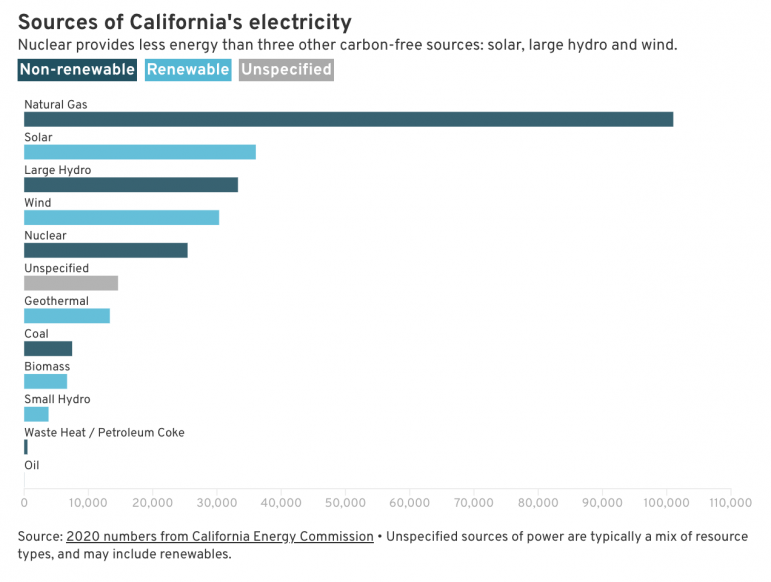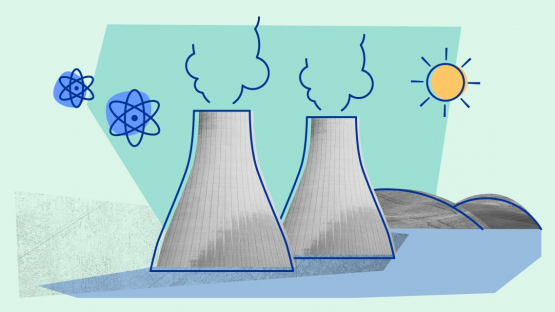That question is at the center of a debate over the state’s use of nuclear power.
Nuclear power does not rely on fossil fuels, so it doesn’t produce large volumes of planet-warming pollutants as other energy sources do. While it’s seen as a climate-friendly alternative, opponents cite safety threats and problems storing radioactive waste.
Now, nearly six years after the decision to close California’s last nuclear power plant — the 2,240-megawatt Diablo Canyon facility — Gov. Gavin Newsom says he is considering applying for federal funding that would keep it open past its scheduled 2025 closure. It’s a move, he said, that could avoid rolling blackouts and power shortages as the state transitions to renewables and braces for more extreme heat, wildfires, drought and floods.
Newsom has until May 19 to apply for the funding and would need the facility’s owner, Pacific Gas & Electric, to get on board, too. Some experts say if Diablo Canyon is shut down, there’s a good chance state officials will be scrambling to replace the lost megawatts.
So what should Californians know about the state’s reliance on nuclear power? Here are five key takeaways:
Diablo Canyon supplies enough power for 3 million people
Perched on California’s gusty Central Coast, Diablo Canyon has been supplying power to the state’s electric grid since 1985. But the plant near San Luis Obispo has been battered by controversy the entire time.
Just a few years into construction, PG&E found the site was near several seismic fault lines. That spurred lawsuits and massive, statewide protests, culminating in the largest arrest in the history of the country’s anti-nuclear movement. Despite the opposition, the plant was completed.
Today, the facility employs about 1,500 workers. Its 2,240 megawatts of electricity generation is roughly enough to support the needs of more than 3 million people, according to PG&E.
Nuclear power accounted for 9.3% of California’s electricity in 2020; natural gas was by far the primary source at about 37%, according to the California Energy Commission.

California gets nuclear power from out of state, too
Most of California’s nuclear energy is generated by Diablo Canyon, but it also imports nuclear-powered electricity from Arizona and Washington state, according to the California Energy Commission.
Twenty-eight states have at least one commercial nuclear reactor. But some also are facing possible closure in the decades to come.
Arizona’s Palo Verde Generating Station is the country’s largest power plant, with three nuclear reactors built in the late 1980s. The Nuclear Regulatory Commission in 2011 granted the plant a license to continue operating until 2047.
Twelve commercial reactors have closed in the past decade, including in New York, Massachusetts, Nebraska and Iowa. Yet Oregon-based NuScale Power recently gained approval to build test reactors in Idaho in 2029 and 2030.
California imports more electricity than any other state — about 30% of its supply in 2020, including some from coal-fired plants that are larges sources of greenhouse gases, according to the California Energy Commission.
Hurdles remain to keeping the plant open
In 2016 PG&E announced plans to permanently shutter Diablo Canyon, noting that the transition to renewable energy would make continued operations too costly. The California Public Utilities Commission approved the closure in 2018, after the utility reached a settlement agreement with advocacy groups and environmentalists. One reactor is slated to close in 2024, followed by the second in 2025.
Faced with a potential power crunch as climate change ravages the state, Newsom said PG&E should consider applying for $6 billion in federal funds that the Biden administration set aside to rescue nuclear plants from closing.
But the prospect of keeping it open could face numerous technical, financial and logistical hurdles.
PG&E and the Nuclear Regulatory Commision, which issues the licenses to keep the plant operating, would have to expedite the renewal process in time for the quickly-approaching shutdown.
PG&E did not respond to multiple requests for comment. In a statement to CalMatters, the CPUC said “all options are on the table.”
“Electricity reliability for California is a main priority,” said spokesperson Terrie Prosper. “Extending the operation of Diablo Canyon will require examination by the CPUC.”
PG&E also would have to address aging infrastructure problems and make investments to comply with the state’s water-cooling regulations, according to Matthew Freedman, a staff attorney with The Utility Reform Network, a consumer advocacy organization.
Delaying the closure could potentially be more expensive for ratepayers. A better alternative would be to improve the state’s energy storage capacity for renewable energy, he said.
“Since the continued operation of Diablo Canyon could prove to be very expensive, any proposal to keep the plant alive must be accompanied by binding cost containment and protections for ratepayers,” Freedman said.
“PG&E’s rates have already been skyrocketing and we want to do everything we can to bring it down. So we’re definitely against any proposal that would give PG&E a blank check.”
Nuclear energy is generated from splitting uranium atoms in a reactor. This process, called fission, produces steam that is then used by turbines to create electricity. The result is a reliable, 24/7 energy supply. But operating the plant still has consequences for communities and the environment.
Nuclear plants require water as a cooling mechanism to prevent them from overheating. That water is often released back into the ocean at a much higher temperature that could damage marine habitats.
And while power plants don’t produce greenhouse gases, they do produce a toxic byproduct: spent nuclear fuel, which must be disposed of safely.

Opponents of nuclear energy argue that people of color, including Black, Latino and Native American communities, are especially vulnerable to harm from mining uranium as well as the disposal and storage of radioactive waste. Companies that operate these plants have long used ancestral native lands and other areas near disadvantaged communities to source materials and store spent fuel, said Shaun Burnie, a senior nuclear specialist with Greenpeace.
Critics of Diablo Canyon also say the facility’s infrastructure is outdated and flawed. Burnie said the threat of earthquakes is a top concern. The 2011 nuclear disaster in Fukushima was caused by an earthquake and subsequent tsunami.
Instead, he said the state should abandon the idea of keeping the plant open, focusing solely on renewable energy projects and decentralizing the power grid.
“It’s a complete distraction, it’s infuriating,” Burnie said. “This is about saving an embattled nuclear industry — it’s not about saving the climate.”
Still, the state’s plan to reduce its reliance on nuclear energy has not been an easy transition. Renewable energy projects have faced delays due to the pandemic and worsening drought could drive declines in hydropower energy production. Heat waves have triggered rolling blackouts and brownouts as demand for electricity soars.
“Our view is that zero-carbon resources are the replacement for Diablo Canyon and we don’t think more fossil fuel generation is needed,” Freedman said. “That being said, we understand that there are challenges with reliability that policymakers are trying to address.”
Proponents laud nuclear power as zero-carbon, lower-cost
Diablo Canyon has played a crucial role in providing carbon-free energy and maintaining the reliability of California’s power grid, said Jacopo Buongiorno, a professor at MIT’s department of nuclear science and engineering. Without it, Buongiorno said, it will be difficult to meet demand as intensifying weather patterns increasingly strain the grid. He said the state needs to rely on all kinds of renewable and carbon-free sources, including nuclear energy, to achieve carbon-neutrality by 2045.
“Given the magnitude of the challenge that we’re facing in terms of decarbonizing and mitigating climate change, I would argue that we should use more nuclear energy, we should use more solar and more wind,” he said. “Everything that does not emit carbon dioxide should be on the table.”
Buongiorno acknowledged safety and nuclear waste concerns, but described the risks as minimal compared to the detrimental effects that fossil fuel emissions have on the environment and heavily-polluted communities. He said the storage of nuclear fuel is also highly regulated and handled in a “safe, effective manner” with the use of dry cast storage.
If Diablo Canyon were to close, maintaining a carbon-neutral grid by 2045 would require more energy storage — at least 18 gigawatts of solar power, according to a joint 2021 Stanford and MIT study co-led by Buongiorno. To build those solar facilities, the state would need about 90,000 acres of land compared to the 900-acre Diablo Canyon site. Finding that available space could be a challenge due to an executive order requiring the state to preserve 30% of its natural and coastal lands by 2030.
The study found that keeping Diablo Canyon open could save an estimated $2.6 billion in power system costs from 2025 to 2035. The price of natural gas has risen recently, so existing nuclear power plants tend to be more competitive, Buongiorno said.
The cost of electricity from solar and battery storage is higher than the cost of Diablo Canyon alone, “so there are savings simply from operating a cheaper asset,” he said.
Excluding the price of nuclear fuel, PG&E spent $1.2 billion in 2021 to operate Diablo Canyon.
Steven Chu, a Stanford University physics professor and the energy secretary during the Obama administration, said the state should be making every effort to reduce its reliance on fossil fuels. Closing Diablo Canyon would only slow that transition, he said.
“Nuclear power may be certainly the lesser of two evils compared to keeping oil and natural gas plants,” he said. “You can’t wave a magic wand and say we go 100% wind and solar because they are intermittent. It’s easy to go from zero to 50%. It’s much harder to go from 50 to 75% and nearly impossible to get to 100%.”